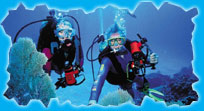

Water Sports
The challenge of a turbulent river is no less than that of the rugged mountains. The icy heights of the Himalayas are the source of some of India's mighty rivers. Fed by innumerable streams they race along tortuous boulder strewn beds, cutting deep gorges and breaking into silvery white rapids. The term 'White water' refers to foamy and whitish appearance of fast flowing water. The white water river rafting is quite thrilling and adventurous. With the intricate network of mountain rivers flowing through a myriad of different colors of rocky Gorges, forests, flowers and high mountain villages, the hills provide ideal locals for the perfect water adventure.

Boating
Boats or small ships have been use since time immemorial. Perhaps the urge to sail across the rivers, seas and oceans urged Man to develop better and huge boats carry livestock, granary and his folk to new places. The ancient Phoenicians were masters in boat building and there is enough evidence to prove that they were masters in boat building and sea faring.
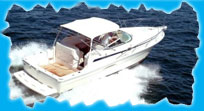
Pleasure boating
Pleasure boating as a family sport is growing in popularity every year. The idea of pleasure boating should have come in existence when the pharaohs used their boats for pleasure cruising on the Nile.
The Pharaohs were so attached to their pleasure boats that they had even buried them in huge chambers along with their mummified remains possibly as a means for a safe journey after life.
The 'Kettuvalams' or the House boats of Kerala, India are an adaptation of the pleasure boats and were in use by the Maharajas for their pleasure cruises in the Backwaters of Kerala now being developed as the West Coast Canal.
The nature of pleasure boating as a sport is such that age appears no barrier to long-term success.
The Catamaran applied to any water craft having twin hulls. Originally it denoted a form of sailing and paddling raft employed on the coasts of India.

Sailing
Sailing as a sport and recreation owes its creation to Piracy. The traders and sea farers were in deep trouble when they couldn't recover their lost assets from the sea thieves. Thus began building 'jaghtschips', or ' hunting ships', the word 'jaght' in Dutch means 'to hunt'.
Sport sailing seems to have originated in the 17th cent. in Holland. From there it was introduced into England (c.1660) by Charles II, and eventually spread to the American colonies. Then, as now, it was common for sport sailors to join together for social and recreational purposes in groups known as yacht clubs.
Ocean racing, an arduous and dangerous sport, especially in long-distance solo events, has gained increased notice. Today's ocean racers sail advanced multi-hulled yachts and are aided by such modern technology as sophisticated communication devices and satellite-generated weather reports.
Sailboat racing has also been part of the Olympic Games since 1900; at present Olympic sailors compete in nine classes ranging from sailboards 12 ft 1 in. (3.7 m) in length to 26-ft 9-in (8.2-m) sloops.
Sailing, traditionally a sport of the wealthy, has been opened to wider participation by modern methods of boat building. For more Visit: Yachts India For packages and deals please contact us at our Travel Desk.
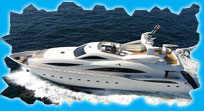
Yachting
The ' jaghtschips', a swift, maneuverable sailing vessel about 14 to 20 m (about 45 to 65 ft) in length was renamed Yachtships by the English, were fast and flexible and were used to catch pirates by their respective Navies. But it soon caught the fancy of the Lords and Kings and they soon adopted them for their pleasure cruising in the Thames River.
King Charles II popularized the sport in England after receiving a yacht as a gift from the Dutch people. In 1720 the first known formal organization of yacht devotees, the Cork Water Club, now the Royal Cork Yacht Club, was founded in Ireland.
The oldest yachting organization still existing is the Royal Yacht Squadron, founded at Cowes, on the Isle of Wight, in 1815 as the Royal Yacht Club of England.
Yachting later developed as Speed Sport and the first recorded Yachting race ' The 100 Guineas Cup race' was held in the year 1851 which involved a 60-mile circuit in the Southern British Island of Isle of Wight.
The Guinea Cup or Queen's Cup, was sponsored by the Royal Yacht Squadron of Britain as part of an international exhibition in London in 1851.
'The Guineas Cup Race' was later renamed as the "Americas Cup' to this day remains a prestigious Sporting event for Yachters. Yachting was later adopted by the International Olympic Committee in 1900 at Paris.
In the late 19th century Yachting was revolutionized by the appearance of various types of power-driven craft, particularly steam yachts. These enormous steam yachts were gradually succeeded by smaller, less costly, cabin cruisers powered by gasoline or diesel engines.
Sailing achieved unprecedented heights of popularity with amateur Yachters after World War II. Reduced maintainence costs with the use of fiberglass and aluminium for hulls and nylons, a general rise in personal income, better communication links and the construction of several Marinas contributed to the surge in Yachting Activity in this century.

Fishing
Sports Fishing or Recreational fishing, which is practiced throughout the world with a set of regulations as to the season in which a certain species of fish may be caught, the minimum permissible size, and the number that may be taken per day, may be done in either fresh or saltwater. The most popular game fish are salmon, trout, bass, and pike in freshwater, and sailfish, tuna, marlin, tarpon, and bonefish in saltwater.
There are many annual tournaments both for catching fish and for accuracy and distance in casting; records are kept for the largest catch in each species.
The International Game Fish Association (founded 1939) standardizes rules for saltwater fishing throughout the world. The largest ratified catch of any type is a 2,664-lb (1,208-kg) white shark caught off the Australian coast in 1959.
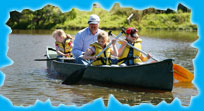
Canoeing
Canoeing Canoeing is a sport of propelling a canoe through water. Canoes are also used as transportation vehicles. It is usually propelled by means of paddles, although sails and, more recently, outboard motors are also used. Racing canoes are propelled by either sails or paddles.
Whitewater canoeing, in which the vessel is navigated through rapids, is quite popular in many areas of the United States.
Canoe racing with paddles first became an official Olympic event at the Berlin games in 1936. The two types of Olympic canoe races are those among kayaks (Arctic canoes) and Canadian canoes.
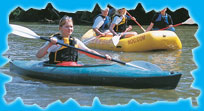
Kayaking
The modern versions of the kayak are also popular as a sporting boat. Kayak events have been a feature of the Olympic games since 1936.
The kayak is propelled by a double-bladed paddle and is primarily a hunting canoe, originally made of sealskin stretched over a framework of whalebone or driftwood. It is completely covered except for the opening in which the paddler sits.
Since the paddler wears a waterproof skin shirt which is laced to the boat, he can turn all the way over without sinking.
A buoyant arctic canoe that is completely covered except for its cockpit(s), is raced by both men and women. The Canadian, the typical North American canoe, is raced only by men.

Rowing
The art of propelling a boat by means of oars operated by hand. Boats propelled by oars were used in ancient times for both war and commerce. Rowing is now generally used only for propelling small boats or for sport.
In modern racing, each member of the rowing team, or crew, uses both hands to pull one oar through the water. The oars, attached to riggings jutting out from the side of the boats to increase leverage, are positioned alternately on opposite sides of the vessel.
The boat, or shell, is sometimes steered by a coxswain, who sits at the back of the vessel and manipulates tiller ropes attached to a rudder; the coxswain also directs the speed and rhythm of the crew's strokes.
Sculling is a variant of rowing in which the rower controls two oars, one in each hand. Sculling teams consist of one, two, or four members; rowing crews have two, four, or eight members, with or without a coxswain.

Surfing
Surfing as a Riding on waves toward the shoreline takes skill, stamina, and agility. After paddling to the point where waves are breaking, a surfer catches a wave and rides it using one of several basic moves.
In the bottom turn, a surfer turns the surfboard sharply off the trough at the base of a wave and uses momentum and speed gathered from the wave's motion to direct the surfboard up the face of the wave-the smooth section below the wave's white crest.
The basic idea behind surfing is to ride the unbroken portion of a wave for as great a distance as possible, using a variety of maneuvers to speed up, slow down, and maneuver around the breaking portion of the wave.
Proficient surfers continue to ride until the entire wave has broken and become whitewater.
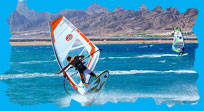
Windsurfing
Windsurfing is the ultimate watersports experience of thrills which can be enjoyed by any age.
The basics:
Being able to get on and off the board without falling off.
Going in a straight line and going backwards safely. Turning while on the move.
Launching the board safely:
This is a challenging sport using nature's cleanest and most powerful forces, that is especially rewarding when you have mastered a skill you'll have for life.
Equipments:
The basic equipments for windsurfing consists of a board and rig, buoyancy aid windsurfer boots and wet suits.
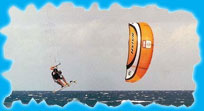
Kite Surfing
Kite surfing has grown into one of the most radical new water sports ever. Advances in kite technology have made a massive difference. Once a very rare sport, kite surfing has now become commonplace in many part of the world.
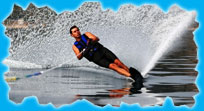
Waterskiing
Waterskiing first appeared in the early 1900s. At the time, it was called "aquaplaning." Aquaplane boards were usually 6 to 10 feet long and 3 feet wide, with a rope tied to the front. The skier or aquaplaner held on to a rope which was attached to the front of the board. This made it possible to stand up and use body weight to manipulate the board. Nowadays, more than 350 waterskiing tournaments take place each year in which records for speed, distance and endurance continue to be broken.

Snorkeling
Is a common form of diving on the surface or just below on the surface. A snorkel is a tube that allows the diver to breathe while floating at the water's surface. One end fits in the diver's mouth and the other end extends above the water.
